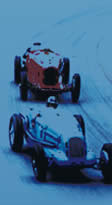


The Talbot Lago Story Once Upon a Time My father, Douglas Charles Pilkington (Pilkie) had been impressed by the Talbots at the Grands Prix at Silverstone and became interested in the road versions. It always seemed to be a good idea to agree with him, so I was with him when he bought a secondhand Lago Record at a Paris garage. In 1958 with my newly acquired 1750 GS Alfa Romeo, I set out to attend the 24 hours of Le Mans - please would I call at Talbots and buy some gearbox bits? Of course! The 1750 parked outside the service department soon brought out Talbots' sales manager, an Italian who said he'd started by selling 1750s. Then Tony Lago came to see why everyone was out on the pavement. After a while I asked him what had become of the Grand Prix cars. "The last one we had has just been sold to the United States", he told me; "but there is one nearby belonging to an ex-racing driver, go and have a look". Being an enthusiastic window shopper, off I went to nearby Puteaux and found the back street garage of Georges Grignard. There was a dusty monoplace Talbot, the first one I had ever seen - For Sale? Yes! The price seemed to be about £1200. Two problems - First the price included all the works spares which he had bought from Lago, a small barn full. Second, my credit line had been stretched to the limit in getting the 1750. Oh well! About to leave and stop wasting any more of the man's time, I rubbed at a dirty window and saw another blue car. "C'est quoi, Monsieur?" A damaged sports car on a truck. It looked as though it had been there for years, and it had. The story unfolded - Three or four years earlier Georges had entered the sports Talbot for Le Mans, with Guy Mairesse as co-pilote. As a shake-down they entered a race at Montlhéry. Getting in an extra bit of practice, Mairesse went out with some slower cars. The driver of a 4cv Renault stopped on the racing line of a fast curve - to ask the marshals why they kept waving blue flags at him and what did it mean! Mairesse swerved, missed him but left the circuit through a fence with concrete posts which did him no good at all - or the car. The legal dust had now settled and the car could be disposed of. But still more than the £16 which was to take me to Le Mans and back! <> Enter once more the parental enthusiasm. Correspondence ensued and a deal was possible. But importing used cars - or any cars privately was officially discouraged - can't be done they said. Someone suggested that if we just arrived with it, what could they do? - charge us duty and let it in. So it had to arrive under its own steam. Hmm! Badly bent car, and the engine needed assembly. Georges Grignard had been using the motor in his single seater for cycle pacing - rushing around Montlhéry with a door strapped on the tail and a cycliste with a huge chain sprocket pedalling about a foot behind, to be sucked along at record breaking speed - takes all sorts! Georges wrote to say that he could get the car ready to take away on a trailer, we replied that we had to get it running, and we would do it ourselves, if we could use his workshop. - OK - "Claude will help". Claude had been Georges' racing mechanic, a small man. This was a problem on the day that it was decided to drop the Talbot monoplace off the jack with the back wheels turning, to save the gearbox. Claude on the jack, his feet left the ground before the jack released from the back axle, Georges drove off for a while towing the dangling Claude behind. Easter holidays, off we went to France in an MGA with a few tools and useful looking hammers, found a room over a café facing the Seine, and went to work next morning. Claude had started to assemble the engine, so the big problem was to make the car appear reasonably legal. This meant cutting off all the flapping aluminium and folding the sharp edges away - fitting little lights on the remains of the front bodywork, fitting a new radiator from the stores and generally hammering things a bit straighter. Engine in, oil into tank - oil on to floor. Out with the tank - welding job. I was learning French all the time, but it was some time before I'd cleaned up the vocabulary I picked up from Claude.
Eventually all ready and down to the local petrol station. Petrol tank damaged so only able to put in a few gallons at a time. Finally set off with the MGA following to pick up the pieces. Thoroughly lost in Northern Paris suburbs trying to find the N1 (no Peripherique, or motorways then) - but no problem with the machinery although the whole thing rattling, especially on the frequent pavé surface. After about 80 miles, the back half of the body started to fall off. This meant that the doors would no longer stay shut. A helpful roadside carpenter supplied us with bits of wood, and some very thick wire and we cobbled it all together, but now had to jump over the wire stretched across the top of the door openings, holding the 'tail' on. This was only a little problem - soon forgotten. When we got to Abbeville, found a hotel with a courtyard for the cars, and promptly ripped the drain plug out of the gearbox on a little metal door stop in the middle of their gateway. The hotelliers were not amused to have 1½ gallons of hot oil in their yard. We were too concerned with our problem to worry about theirs. "Wait until tomorrow and have dinner!" Next morning - still not raining - bought more oil, shaved a champagne cork to fit the hole and wired it in, away again and reached Le Touquet without more trouble. Why Le Touquet? Silver City Airways. A short flight in a Bristol Freighter, followed by a drive to London. Only ran out of petrol once. It did not occur to me at that time to do other than restore the sports car body, although when the crashed body was off, the remaining car looked quite racey, with pointed fuel tank exposed etc. I certainly did not realise that the car had started out as an open wheeler, with cycle mudguards.
Much later its earlier history gradually came to light. Although entered for Le Mans 1950, this car was not finished in time, and Rosier won the race in a sister car. By 1951 our car was in the team and fitted with the latest twin ignition head, so it was allocated to Rosier to drive with a new star from Argentina, J.M. Fangio, to help him out. All went well until the oil tank split (it lives behind the dashboard above the driver's legs) and dumped gallons of very hot castor oil into Fangio's lap. I could see by his pained expression when telling me this, that he remembered it well. <> Rosier later bought the car, during one of Talbot-Darracq's frequent financial crises and used it as a second string G.P. car to his regular monoplace although he transferred the later type of carburettors to his single seater – where they still are – marked with my engine number ….! Rosier had a big Renault dealership in Clermont Ferrand - where occasionally he produced small quantities of special bodied Renaults - the coachwork being carried out by Rocco Motto and his Carrozzeria Motto in Turin. Motto was therefore the choice when it was decided to re-body the sports car. The regulations for sports car racing now banned cycle type mudguards and the other team cars had already been fitted with full-width bodies - one was the Levegh car that so nearly won at Le Mans, driven single handed. Rosier was really more involved with G.P. racing in his single seater, and used the 'Motto barquette' very little - he entered it for the 1952 Monaco G.P., which was for sports cars, where it was driven by Trintignant. It was entered for Le Mans but didn't race, and was driven by Chaboud in the G.P. of Rheims. In 1953 it was sold to Georges Grignard. Georges had an inexperienced co-driver for the 12 hours of Casablanca, who got so carried away that he ignored the mechanic waving a huge re-fuelling funnel at him lap after lap until he ran out of petrol. Then the big crash in 1954. When the Talbot was finally all straight again, I started to use it on the road. This was a bit tricky sometimes, especially in London, as with no clutch and a cold Wilson gearbox, it could need some outside help to fire up. Off to Guernsey for its first competitive event, The Val des Terres hill climb and a cup for fastest "visitor". While in Guernsey I met a girl named Trisha who must have been impressed as she is still around, and cadging a lift occasionally, as she did on the occasion of my first race at Goodwood. Returning to London in a rain storm, we did a fast 360° spin on the dual carriageway near Gatwick. Just a little too much right foot and I realised that using the old tyres which I got from Phi-Phi Etancelin - they were probably 15 years old by then - was not wise.
Fortunately Motto had done little to alter the car, simply welding outriggers to the chassis to carry the wide body. This made my eventual re-body to original spec. fairly easy as all the screw holes for fitting the panels were still there, in the scuttle sub-frame, radiator etc. It was not really a re-bodying job, but just the panels - the undertrays, flooring and fuel tank were original. Peels of Kingston did the work for £54. So, I had my single-seater, albeit a right hand drive car, what the French call a "monoplace décallée". Also, when I eventually made the missing cycle type mudguards, I had an authentic sports racer once driven by Fangio and Rosier at Le Mans. The Talbot has served me well since then as we have competed in over 200 races with few problem. <> <><>
|